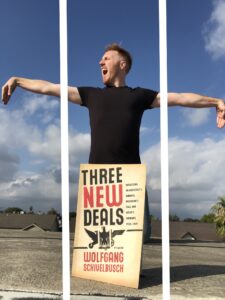 While the Great Depression started in the United States with a stock market crash in 1929, it quickly spread around the globe throughout the 1930s, eventually affecting nearly every country on earth. International trade fell by a whopping 50% and many countries experienced severe unemployment—some estimate as high as 25% in the United States. Many nations struggled until the Second World War put economies back into action.
While the Great Depression started in the United States with a stock market crash in 1929, it quickly spread around the globe throughout the 1930s, eventually affecting nearly every country on earth. International trade fell by a whopping 50% and many countries experienced severe unemployment—some estimate as high as 25% in the United States. Many nations struggled until the Second World War put economies back into action.
Major crises (war; pandemics; economic disasters) almost always lead to more power for those in leadership positions. Perhaps it is the instinctual fear that exists within us humans that causes us to look for someone competent and powerful who will tell us everything is going to be okay when life looks bleak. After the terrorist attacks of September 11th, 2001, for example, President George W. Bush was given a ‘blank check’ and used it to invade the Middle East and massively expand the US government’s surveillance capabilities. This is the same power that was once given to Roosevelt, Hitler, and Mussolini in the wake of the Great Depression, a time in history that produced a similar reaction by many governments from around the world: the centralization of power.
Mussolini, Hitler, and Roosevelt were all charismatic individuals who were given a ‘blank check’ of their own, and this book highlights the similarities in the way they spent it (while also acknowledging their drastic differences—Roosevelt never expressed racism or antisemitism the way his European counterparts did, for example). They all placed an emphasis on national unity, manipulated their citizenry via the use of propaganda, and funded public works as a means of reshaping their societies.
All governments use propaganda to influence their citizenry. Mussolini, Hitler, and Roosevelt propagandized their people with ideals surrounding national unity and all three were largely successful. Interestingly, all three used eagles as central pieces of their political symbols, however, as one historian wrote about Roosevelt’s blue eagle campaign, it was “based on voluntary cooperation, but those who did not volunteer to cooperate were to be forced into participation.” Something similar can be said about Italy under Mussolini’s rule and Germany under Hitler’s. Coming together to solve collective problems is indeed often the surest way to prosperity, and as “divergent as the New Deal and Nazism were when it came to application of direct state coercion, they were similar in their political rhetoric and the underlying psychology behind that rhetoric.” If you weren’t with them, you were against them.
Despite the fact that the United States was a liberal democracy and Germany a repressive dictatorship, both Roosevelt and Hitler (and Mussolini) “depicted their rise to power as the concrete realization of the idea of the nation,” each casting himself as the sole strong man capable of leading his country out of chaos and depression. Roosevelt spoke to his citizens via the radio and his weekly fireside chats and Hitler and Mussolini spoke to their supporters at massive outdoor rallies. In both realms, the effect was the same: people felt as though their leaders were taking care of them. In their own way, they were.
All three of these leading men invested heavily in public works projects as a means of uniting their people and showing them that a better world could exist. The problem, of course, as the history of communism teaches us, is that society can very seldomly be built from the top down—it is most successful when it is built bottom up. So, while the attempts at building new communities were mostly failures, the successes were found in areas of public utility: roads, canals, bridges, highways, hospitals, and schools. Germany’s autobahn highway was started by Hitler during this time.
While we may be able to look back at history and see Roosevelt’s expansion of social services as empathetic towards the starving lower classes and Hitler’s persecution of Jews as genocide, we can nevertheless identify in both governments (as well as Mussolini’s) a “seismic historical change from liberal to state capitalism, replete with a welfare state and government planning and direction of society.”


Leave a Reply